“Restrictions breed creativity,”
Mark Rosewater and Patrick Chapin are well-known to say — so taking this on board, when a format restricts what zones of play exist, the quality of cards you’ll be playing with, or requires you to drink to excess, you certainly have to get creative in order to do well.
Every December, The Games Club here in London runs its annual Christmas event, featuring unsanctioned formats we’d never usually play, with exactly such rules. It’s pretty much the best day of Magic you’ll ever have, as each of the three tournaments are pretty cheap to enter with good prize offerings. The emphasis is very much on having fun, and best of all, you get a Christmas dinner as part of your entry fee!
In this article, I’ll explain each of these formats and their restrictions a little more, offer some strategy on how to win in them, and report on my own performance in each event.
(Note: for each section below, the suggestions/predictions were written beforehand — everything else came afterward).
Ironman Sealed
The restrictions
Ironman Magic is certainly not recommended for those who like all their cards in mint condition. Because once you’ve played a game under these rules, a decent number of your cards are going to look like this:
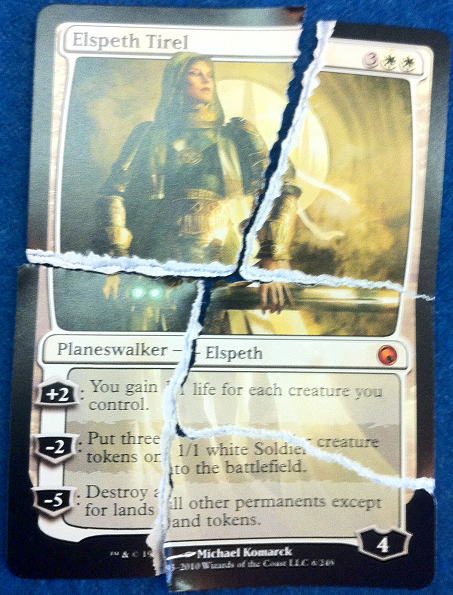
Yea, that’s not playable anymore. Even in a sleeve. I’d definitely call judge on that.
To explain — Under Ironman rules, if a card would enter a zone other than a player’s library, hand, the stack, or the battlefield, it must be
physically destroyed
.
There’s no exile zone, and there are no graveyards. Well, not under game rules anyway, although a pile like this at the side of your game where cards go to die could be a considered a graveyard of sorts:
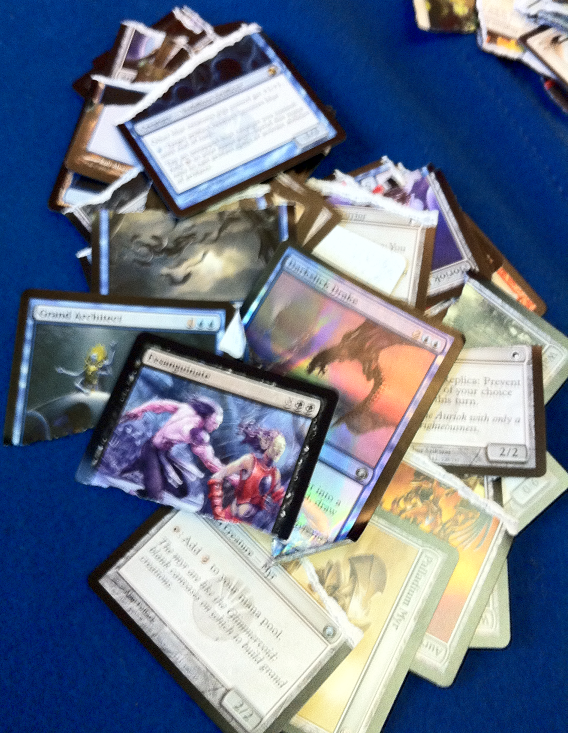
As such, games are best of one, and tournaments are necessarily single-elimination — with the winner of each game receiving all the non-destroyed cards from their defeated opponent to add to their existing pool and to build a new deck for the next round. We always start with a four-booster pool, and the overall winner receives
all
of the non-destroyed cards — often including many pricey rares and mythics.
Let’s get creative
There’s only one game, so you may want to run some “situational” cards, just to avoid getting blown out by a particular card or deck/strategy (Naturalize effects, answers to any possible bomb that scares you, cards that give you time against the most aggressive deck in the format, etc.).
The most important cards are those that generate card advantage or are removal that are
permanents
.
Removal is always good, but if it’s an instant or sorcery, it’s strictly one use, whereas something like Flame-Tongue Kavu, Mulldrifter, Oblivion Ring, or Journey to Nowhere could be used in several games.
 “Blink” effects are
way
overpowered — Mistmeadow Witch, while fragile, may be the best card ever printed for Ironman, effectively having the ability 2UW: Vindicate.
Some cards are totally useless, or far less good than usual — Tarmogoyf is always a 0/1, reanimation spells suck, and so on.
You should ignore the monetary value of cards. Unless you win the entire tournament, you’re not getting prizes, so it’s better to risk having to tear up a Jace, the Mind Sculptor now and have a chance to win another one and a pile of other cards later than leave it in your sideboard and lose your match. Many people will play timidly with high-value cards in Ironman. Be bold and sacrifice whatever necessary to win!
On the other side of that, don’t underestimate the psychological impact of making your opponent rip up a planeswalker or other card they really wanted to take home. Most people are okay with it, but against some opponents, discard and mill effects can be killer, even if they don’t really fit your strategy. In spite of this, I wouldn’t say they’re auto-plays though.
It may be ideal to completely rebuild your deck between games (rather than just augmenting it with cards you’ve acquired), changing colors and/or deck archetype. As your cardpool grows, it may mean a different deck will be stronger or even that a new archetype is viable.
Decks will have less unique cards (there’ll be more multiples of key cards in decks) as rounds go on, so the range of cards you’ll play against decreases.
You may in later rounds have multiples of rares that are normally unplayable but improve massively in multiples (e.g. mill cards), making normally niche archetypes attractive.
Later games will either be incredibly one-sided or go very long. As such, you may want to consider going up to 42/43 cards to ensure you’ll win if your game goes to decking.
There’s always someone who misunderstands the rules and assumes bounce spells (Disperse, Into the Roil, Boomerang) act as Vindicate effects. Don’t be that guy.
Don’t play too few lands or keep dicey hands, as getting mana-screwed is probably the easiest way to lose best-of-one matches.
If you get a bye round 1, you’re pretty much ****ed. You’ll play round 2 against someone with a deck built from a pool roughly twice the size of yours, so you’re going to need to be lucky to beat them. If you do though, you should have a better chance from thereon in, though you’ll always be four packs behind any non-bye opponents.
SOM-specific strategy and predictions
On the situational cards front, you don’t want to roll over to infect (though I wouldn’t expect to face such a deck until round 2/3, before which players shouldn’t have a critical mass of such cards). So, you may get value out of something like Soul Parry, normally a great sideboard card against infect but with uses in other matchups also. Likewise Fulgent Distraction, Abuna Acolyte,
maybe
Blunt the Assault.
The permanent-based removal and card advantage in this set comes through cards such as Skinrender, Oxidda Scrapmelter, the Smith cycle, and Arrest (which is kind of like Mind Control — only you get the creature in the next game rather than now).
 “Blink” effects — Glimmerpoint Stag is the #1 card in SOM for Ironman, being 2WW for a 3/3 vigilance that destroys a permanent when it enters the battlefield. Venser’s +1 is
bad
.
Cards that are either useless or significantly worse than usual — imprint does precisely nothing, meaning Prototype Portal is easily the worst card in the set, shortly followed by Mimic Vat. Corpse Cur can’t return anything, and the lack of graveyards also means that you can’t draw a card off a Spellbomb (look out for this; it’s probably the easiest cheat to commit, even if accidental). Geth, Lord of the Vault is much less backbreaking to face down, and Necrotic Ooze is a mediocre 4/3 for four.
Deck predictions: Here’s what I think three different deck types could look like after a few rounds — each featuring multiples of key cards and powerful bombs.
W/B
5 Arrest
4 Glimmerpoint Stag
4 Skinrender
3 mana Myr
2 Carnifex Demon
1 Steel Hellkite
1 Soul Parry
1 Wurmcoil Engine
17 lands
Infect
3 Ichorclaw Myr
5 Plague Stinger
4 Cystbearer
4 Contagious Nim
2 Tel-Jilad Fallen
2 Untamed Might
2 Carnifex Demon
1 Trigon of Rage
Mono-U Proliferate Mill
3 Grindclock
4 Contagion Clasp
4 Screeching Silcaw
1 Contagion Engine
2 Disperse
3 Silver Myr
1 Steel Hellkite
1 Wurmcoil Engine
1 Trigon of Corruption
3 Tumble Magnet
17 Islands
My pool and build
Though we only had four packs of cards in our initial pool, after sorting by color, I saw a high number of playable artifacts — which is fortunate as it would help me avoid playing a three-color deck and would ensure that even if I drew the wrong color of lands, drawing enough of them would enable me to play most of my cards.
Next, the rares: Engulfing Slagwurm, Tower of Calamities (slow, but a good source of permanent-based removal once active), Kuldotha Phoenix (which I also missed earlier as being less powerful than usual), and an unplayable Molten Psyche. Checking for infect cards, there were only four, so these were quickly ruled out. As were white and black, neither color offering removal or more than a couple of average creatures. This left green, with pretty much just the Slagwurm and a Bellowing Tanglewurm, red with the Phoenix and my solid removal spell in Turn to Slag, and blue, with a couple fliers, counters, and Scrapdiver Serpent. While I did play two Forests, I opted not to play the Wurm as my only green spell and battled with the following, just adding the playable blue and red cards to the base of fifteen artifacts.
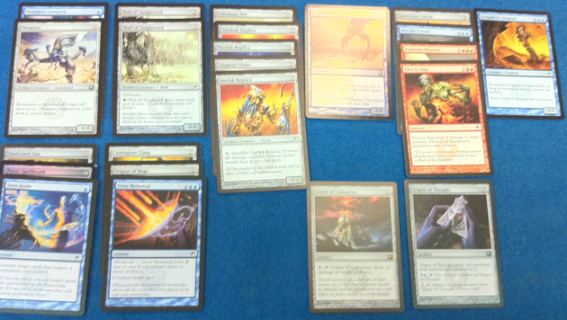
Auriok Replica
Darkslick Drake
Kuldotha Phoenix
Memnite
Moriok Replica
Palladium Myr
Saberclaw Golem
Scrapdiver Serpent
Sky-Eel School
Snapsail Glider
Vedalken Certarch
Vulshok Replica
2 Wall of Tanglecord
Contagion Clasp
Darksteel Axe
Panic Spellbomb
Stoic Rebuttal
Tower of Calamities
Trigon of Rage
Trigon of Thought
Turn Aside
Turn to Slag
Cards of note include the two Walls of Tanglecord, which would be excellent in preventing a loss to a very aggressive deck, and the Vedalken Certarch, which with enough artifacts should be able to stop many bombs or be used offensively to remove blockers. Both of these play into the deck’s plan of stalling out to a great endgame of a flying/unblockable beater or just cleaning up with the Tower of Calamities and getting in for two a bunch of times. The Trigons in conjunction with the Contagion Clasp also make for a nice grinding finish.
Round 1 vs. Ricky Nunn (G/B/u Infect)
I was quite surprised to see Ricky playing an infect deck in four-pack Sealed, as I hadn’t thought the card pools would contain enough of the necessary cards this early. However his deck was not purely infect creatures, though he did have a Grafted Exoskeleton to make any other creature a poisonous threat.
The game started with me on the back foot, though the first Wall of Tanglecord managed to soak up three or four attacks, by which time I had some fliers and a metalcrafted Vedalken Certarch. I looked to be ahead, getting in a few attacks until he found the equipment and got rid of the Certarch, creating a stalemate. Neither of us could profitably attack for a while, while I built up what looked to be a game-winning set of artifacts in Contagion Clasp, both Trigons, and a Tower of Calamities that would clear his board over the next few turns. At this point, each of us had gone through well over half of our decks, and we were the last match still playing. Alas, with an alpha strike followed by a huge, peeled Exsanguinate, Ricky killed me with regular damage, unable to deal me the final three poison counters.
Despite all his strategic planning, your hero failed you on this one; sorry, boys and girls!
Predictions?
While I didn’t get to the final, I made sure to check out what the two players battling there were playing —
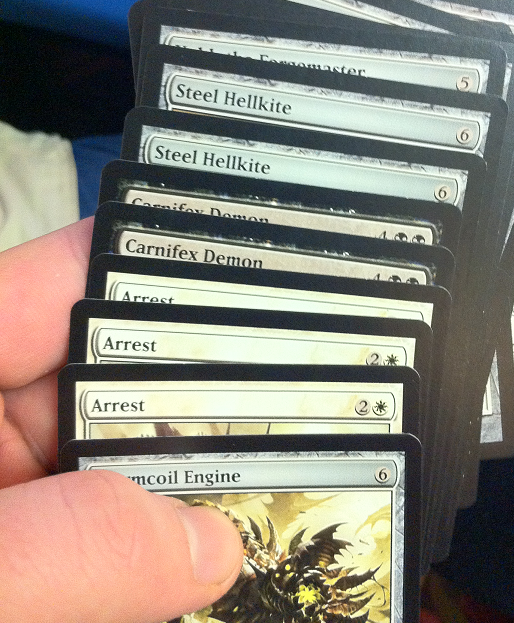
Here are the choice cards from the first finalist Larry Devis’s deck — very much along the lines of my W/B prediction, he had a couple each of Skinrender and Glimmerpoint Stag also.
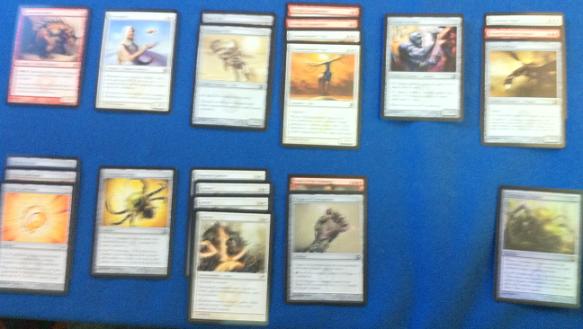
And here’s the entire deck played by eventual winner Vladimir Marko — his deck again containing many of the white and artifact bombs in my lists above, with some planeswalker action to boot. I’d like to say their final was an epic battle, but sadly it was multiple bombs vs. not enough lands, making for a fast and lopsided game and leaving Vlad with well over £100 (~$160) of surviving cards.
(As a consolation, Larry was entitled to receive all of the destroyed cards. He elected not to take them home with him).
Reject Rare Draft (RRD)
The restrictions
In this draft format, every pick you get a rare or mythic! The problem is, it’s worth nothing, isn’t very good, and probably costs seven mana.
RRD works just like a regular 8-man draft, only each pack is composed of those hopeless ten-cent rares that nobody ever wanted to play (packs roughly color-balanced and without multiples, naturally). This makes for both an excellent opportunity to clear the trash out of your binder and a format approximately the opposite of triple-Zendikar in pace.
In addition, our event is the highest-EV Magic tournament you’ll ever find — you need only supply 45 cards to enter (which can be purchased in bulk, then sold back to Mike the trader for a net cost of 50p or less), and the prize support consists of all the past year’s unclaimed prizes and lost property (including complete decks). To make this abundantly clear: in 2009, I went 2-1-0 and got seventeen booster packs.
Let’s get creative
“
It’s easier to fight your mana base than the power level of your deck.
” Rob Stanjer has given me this piece of advice on several occasions, and it’s not something I’ve heard elsewhere, so it’s worth considering for a moment. What Rob means here is that in certain formats, it’s better to have a shaky mana base (you’ll remember the 6/6/5 Shards of Alara special) with more powerful cards, than it is to have a consistent two-color deck that has much weaker cards. There’s a chance you’ll draw your third/fourth color of land for the splashy bomb in your hand — there’s no chance of drawing a card better than the best card in your deck. In RRD, playing three colors, equally, with prohibitive double and triple colored mana costs is the norm — it’s better to risk this than play cards you can’t win with!
Play more lands than usual, eighteen or nineteen — you’ll likely have a very high curve, so ensure you hit all your land drops. There’s also sparse mana fixing, so playing a greater number of lands gives you more chances to draw e.g. your third Mountain.
Removal is exceptionally hard to find (if you end up with more than two pieces, your deck is well above average), so prioritize it even higher than you would normally. If you see any form of mass removal (even if it’s of a color you’re not in
yet
), take it!
Likewise, anything that generates card advantage is also difficult to find — so any card with a repeatable effect (even at a high cost), or that allows you to draw a card, is excellent.
Pick creatures above any non-removal cards — it’s easy to not pick enough and end up with a deck that can’t realistically win.
Low-casting-cost creatures are excellent — a Gray Ogre or a 3/3 for five is a pretty high pick. The easiest way to win a game in this format is to curve out before your opponent does (see:
Gavin Verhey ABC — Always Be Clocking
). If your deck can reliably play a creature on turns 3, 4, and 5, you’ll do well.
As such, offcolor morphs you’ll always play and are high picks — especially if you have morphs you can play the activation cost of, as after game one, your opponent will have some guessing to do when you play one.
Any creatures with evasion are more important than usual — with far less removal and still a limited number of these, it’s possible your opponent won’t have an answer in
her deck
to a 4/4 flier for six, giving you easy wins on the back of them.
There are a great number of cards that simply do nothing, except possibly in some combo that you’re unlikely to get out given your lack of card draw/tutoring. Don’t take these, instead taking any creature, even if you’re unlikely to play it.
If you have to take a noncreature card that isn’t removal, cards with cycling are the best of a bad bunch, especially those that do so for a single colored mana. I’d quite happily cycle on turns 1 and 2 to ensure a turn 3 creature than play more top-end stuff. Toward the end of a pack, if you have to take something you know you won’t play, choose the card that could
somehow
kill you.
If the packs oblige, it’s possible to completely cut one of your neighbors out of creatures. If you see the shot, take it.
Given the glacial pace and lack of card advantage in the format, it’s almost always correct to draw. Of course, if you end up with the freak deck with six morphs that curves out at five instead of eight/nine, you know what to do.
Given the lack of removal and counterspells, you can be more certain than usual that your spells will resolve and your creatures will live — so it’s usually safe to play into open mana from your opponent.
My draft picks and build
Pack 1:
Primal Whisperer
Cragganwick Cremator
Mahotmi Djinn
Eron the Relentless
Lichenthrope
Insist
Blizzard Elemental
Rapid Decay
Reki, History of Kamigawa
Ebonblade Reaper
Selfless Exorcist
Borderland Behemoth
Zur’s Weirding
Vassal’s Duty
Part the Veil
Pack 2:
Arcanis the Omnipotent (A must-play — why is this even in RRD?)
Stone-Tongue Basilisk
Paleoloth
Synapse Sliver
Scragnoth
Rath’s Edge
Clockwork Beast
Cockatrice
Loxodon Peacekeeper
Storm Spirit (Flier and repeatable damage, a must-play — I’ll now try to be U/G/W)
Exiled Doomsayer
Ghosts of the Innocent
Baneful Omen (Nicely hated over two cards that do nothing)
Overburden
Planar Overlay
Pack 3:
Chronozoa (Must-play, will take over games)
Valleymaker
Elder Druid
Hedron-Field Purists
Feral Hydra (First-pick and would be even as a 2G 2/2 with that ability)
Cylian Sunsinger
Evangelize (Does my pod not like Mind Control?)
Global Ruin
An-Havva Constable
Rayne, Academy Chancellor
Junkyo Bell
Chronosavant
Rally the Herd
Reverse Damage
Repay in Kind
I tried to stay true to my strategy above in the draft, picking up creatures wherever possible and staying loose on the colors front to begin with, though I did mispick a couple more expensive cards (notably: Stone Tongue Basilisk) over morphs. The build is fairly straightforward, maximizing the number of early creatures, with these plus Global Ruin giving a chance at something similar to the old “White Weenies into Armageddon” plan. If the game goes longer, repeatable effects on Arcanis, Paleoloth, and Storm Spirit should allow me to pull ahead. The Rayne and Insist might be incorrect and perhaps should’ve been even more lands.
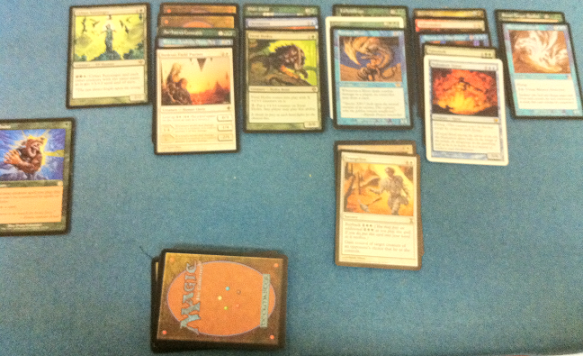
An-Havva Constable
Arcanis the Omnipotent
Blizzard Elemental
Chronozoa
Cockatrice
Cylian Sunsinger
Ebonblade Reaper
Elder Druid
Evangelize
Feral Hydra
Global Ruin
Hedron-Field Purists
Insist
Lichenthrope
Mahotmi Djinn
Paleoloth
Primal Whisperer
Rath’s Edge
Rayne, Academy Chancellor
Stone Tongue Basilisk
Storm Spirit
Synapse Sliver
Valleymaker
18 basic lands (7 Forest 7 Island 4 Plains?)
Round 1 vs. Ed Hughes (R/W/B Confusion in the Ranks combo)
Ed’s deck is difficult to figure out in game one, as he doesn’t do anything for the first few turns while I play some guys; then he casts Spoils of the Vault, naming Confusion in the Ranks (losing about ten life), casts it, and dies before his next turn. Game two, things are a little clearer, as he casts the tutor turn 1, loses only three life this time, casts the enchantment, then steals my board with a Knight-Captain of Eos, before beating me about the face soundly. Game three, he doesn’t achieve the combo, but I play more creatures than he does and win.
His deck was certainly neat, featuring token generators such as Icatian Town to go with the Confusion and nasty disruption in Head Games, but I definitely think that if the enchantment and tutors were creatures, his deck would’ve been a lot stronger and could have better capitalized on the Head Games he never drew.
Round 2 vs. Marek Pieprzyk (U/x Empyrial Plate)
I forget what Marek’s second color was, but his deck was built around the super-nombo that is: Empyrial Plate + Thought Devourer, with two copies of each. No jokes, that’s a top-tier deck in this format, and all of those cards must’ve been picked up early, as I didn’t see any of them.
Game one he assembles a 7/7 flier on turn 5, and I quickly die. Game two, he gets Plate but no flier, and I win the race by trading with his guys and growing a Chronozoa army. In the final game, he again assembles the “combo” on turn five 5; I take seven, then cast Evangelize next turn. AWWW YEAAA!
Round 3- DNF
Due to the last (and most important) event of the day starting, most of us drop before round 3, save Gary, who negotiates a deal whereby he gets to play his round and have his girlfriend draft on his behalf. Having been denied the ID (pretty silly move on his opponent’s behalf, it would’ve guaranteed them top 3 finishes), he obviously crushes 2-0, while his darling Estelle forces infect in her first ever draft.
Prizes were drafted from this table (this picture taken after about ten picks) — we’re not allowed to look in or pick up any of the boxes, so they’re a real gamble:
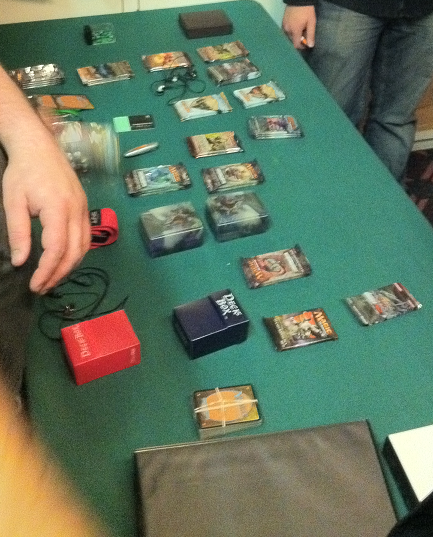
Gary ends up with a partial deck containing: three Cryptic Commands, Day of Judgment, Wrath of God, Tezzeret the Seeker, two fetches, a few Ravnica dual lands, two Pithing Needles, and ~fifteen boosters, for approximately 160 times his entry fee in prizes. In perspective, that would be nearly a $5k first prize for a $30 entry tournament, if scaled up.
For my 2-1 record, I earn eleven boosters, a Mitotic Slime promo, two Liliana’s Specter promos. Having only paid 35p to enter, that’s roughly 80 times my entry fee in prize value for two rounds played!
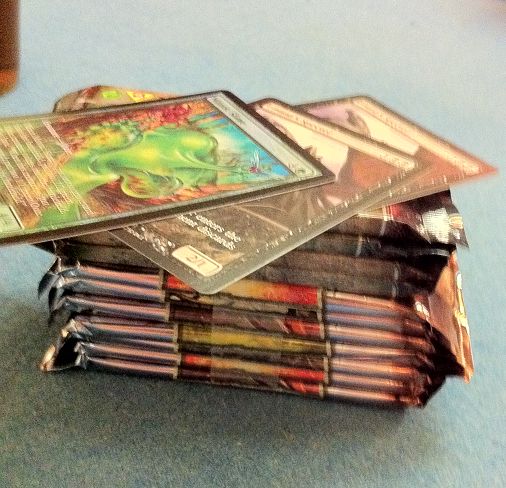
The Keith Lovey’s
The restrictions
“The winner is often not the best player” — tournament motto.
The Keith Lovey’s is a memorial draft held each Christmas, to celebrate the life of a local Magic player who sadly died a few years ago. Keith was well known locally for always buying two pints at a time from the bar during events, maintaining it was more efficient that way.
The rules of the tournament are simple and based on this peculiarity of drink purchasing — during the draft/deck construction and each round of play, players must consume a minimum of two pints of liquid and four units of alcohol. Two pints (proper UK 20 oz. ones, Americans!) of lager, bitter, or cider, in other words. Failure to finish a drink in the allotted time results in a game loss for each drink unfinished, and players found to be cheating by “undrinking” (intentionally or accidentally) are disqualified. All players draft in a single large pod, and there are five Swiss rounds of play.
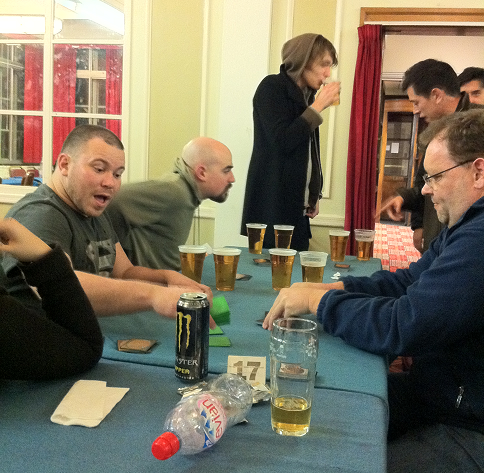
Let’s get creative
My advice to anyone who attempts such a challenge — make sure you’ve eaten plenty an hour or two beforehand, and drink bitter (it’s slightly weaker and much less fizzy than lager). It also helps to have a high alcohol tolerance (students should do well) and to play a strategy you could pilot while asleep (which you may well be). I’d know — last year I conceded the final after winning* with R/B in triple Zendikar.
Oh, and don’t be afraid to call judge if your opponent isn’t drinking enough!
My draft picks
Pack 1:
Contagion Clasp
Origin Spellbomb
Galvanic Blast
Panic Spellbomb
Myrsmith
Tumble Magnet
Bloodshot Trainee
Sylvok Lifestaff
Soul Parry (sb)
Riddlesmith
Bonds of Quicksilver
Oxidda Daredevil
Lumengrid Drake
Golden Urn
Pack 2:
Tumble Magnet
Ghalma’s Warden
Vulshok Replica
Glint Hawk Idol (over Volition Reins)
Glint Hawk
Blade-Tribe Berserkers
Trinket Mage
Bonds of Quicksilver
Flight Spellbomb
Abuna Acolyte (sb)
Vulshok Heartstoker
Kuldotha Rebirth (sb)
Twisted Image
Melt Terrain
Pack 3:
Venser, the Sojourner (Windmill!)
Embersmith
Turn to Slag
Arrest (over Volition Reins)
Glint Hawk
Origin Spellbomb
Glint Hawk
Instill Infection
Liquimetal Coating
Auriok Replica
Golden Urn
Volition Reins (!!!)
Golden Urn
Halt Order (sb?)
Deck build and pick discussion
I set out to draft an aggressive linear strategy, either W/R Metalcraft or Infect — something simple to play that would give me time at the end of rounds to focus on finishing my drinks. It was clear from the offset that Infect wasn’t going to pan out, so I quickly settled into W/R, though picking up some blue cards I considered splashable along the way. A key decision was Glint Hawk Idol over Volition Reins p2p4 — I didn’t want to jump ship and generally don’t like playing blue-based decks in this format. However after Trinket Mage and then Venser popped up, I was definitely splashing blue, and after that super-late Volition Reins pack 3, I realized I could be W/U/r rather than W/R/u and sleeved this up:
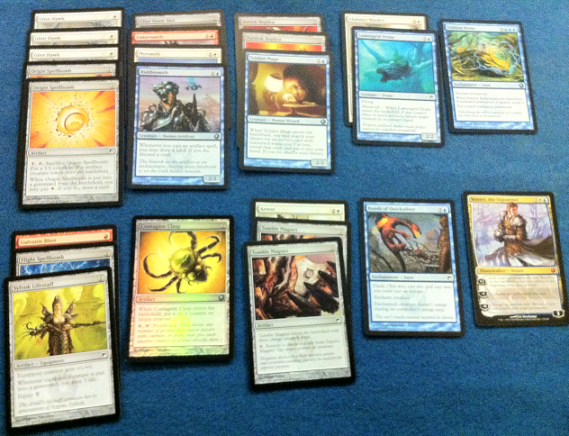
Auriok Replica
Embersmith
Ghalma’s Warden
3 Glint Hawk
Lumengrid Drake
Myrsmith
Riddlesmith
Trinket Mage
Arrest
Bonds of Quicksilver
Contagion Clasp
Flight Spellbomb
Galvanic Blast
Glint Hawk Idol
2 Origin Spellbomb
Sylvok Lifestaff
2 Tumble Magnet
Venser, the Sojourner
Volition Reins
It wasn’t the easy-to-play aggressive deck I was initially planning on, but it’s one of my better SOM drafts and was a blast to play — one of those decks with plenty to do that makes you feel very clever when playing it well. I’m particularly happy with the sideboard cards I picked up, figuring many people would default to Infect. Soul Parry, Abuna Acolyte, Kuldotha Rebirth (if I’d played a red base), along with my maindeck Auriok Replica would give me a lot of game against poisonous foes.
Round 1 vs. Phil Rogers (Mono-Blue Artifacts)
(
My actual notes from the night in italics
)
“Played Venser t5 both games, and it was SICK. My technical play was good with all the triggers and proliferate and stuff; this must be what it feels like to be Brian Kibler on Day 1 of a PT or something! Super confident now. My deck kicks a**! Feeling a bit drunk now, four pints down.”
Phil, our local scorekeeper, had a not-particularly-great mono-blue deck, which, despite some good cards (Volition Reins), didn’t fare well against Venser, particularly when he neglected to attack into it on a couple of turns, allowing me to get an emblem while keeping my planeswalker alive. In both games, I was doing quite a lot, blinking Glint Hawk to replay a Spellbomb for additional Smith activations and so on.
Round 2 vs. Ricky Nunn (G/B/r Infect)
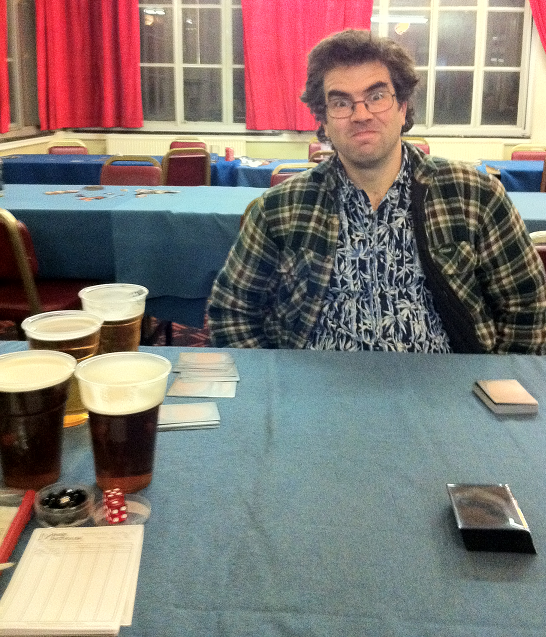
“I kept a hand that probably would have worked out against anything else but quickly lost to his very aggressive draw on the play, two Untamed Mights on successive turns finishing me off.
I was glad to know he had both the Mights (I’d have to play around it even more) and was glad to have excellent sideboard cards for the matchup!
OUT: Sylvok Lifestaff, Lumengrid Drake
IN: Abuna Acolyte, Soul Parry
I won game 2 easily, taking no damage or poison, after a blowout Soul Parry after he used an Untamed Might on a multiple-blocked creature. Five pints.
Game 3 I only took one poison but was much more of a grind, as I used two Tumble Magnets and Contagion Clasp defensively with little board presence until Venser and some more creatures arrived. Six pints. Feeling v. confident.”
If you learn one thing from this report, I must surely have hammered it home by now — draft sideboard cards!
Round 3 vs. Rik Powell (U/x ??)
“After discussing under what circumstances you’d scoop to someone knowing you can’t finish a tournament, Hana calls and asks me to come home, rather distressed — on her walk home from Stevie’s, some creeper has grabbed her and touched her face before she broke free and ran home. I say I’ll come home ASAP despite her protestations and scoop to Rik.
We play one quick game while I finish pint #7, before giving pint #8 to Gary. I lost to Sword of Body and Mind on Neurok Invisimancer but felt it would’ve been a close three-game match if we’d played it out.”
One other thing to learn from this report that may not have been said a hundred times before — sometimes real life is more important than Magic. Sorry to cut my side of things short here, but needs must, and I did some investigations to give you a conclusion…
After I left…
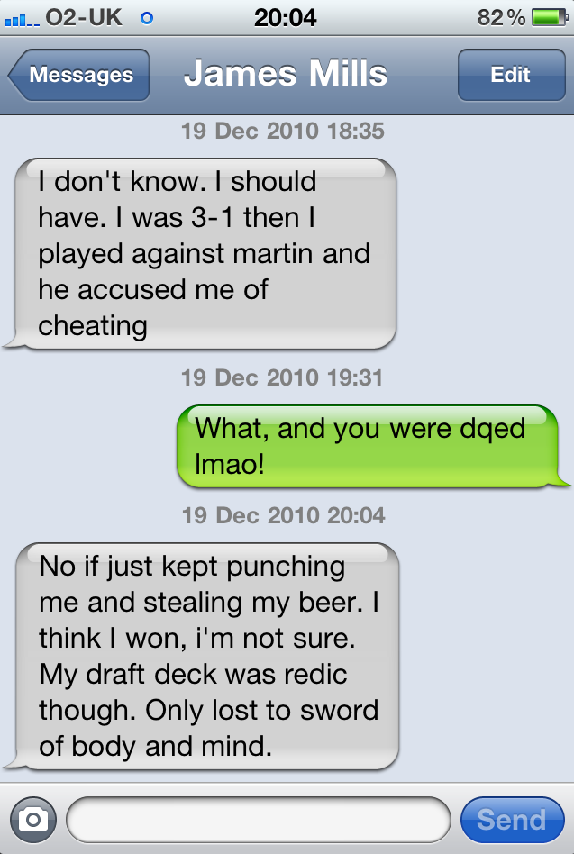
I got this from Mills the following evening, but there was no clear winner at this point. Other reports by email, text, and forum post were equally hazy.
Finally, I received an email three weeks later explaining the outcome: Following a ruling by the Keith Lovey Memorial Rules Panel, it was decided that Rik Powell would be disqualified for his inability to complete the final round, thus giving the win to defending champion Jason Howlett., who drafted a “B/U unblockable poison” deck.
Further claims of players discarding drinks, cheating, bribing their opponents, or being forcibly removed from a post-tournament gentleman’s club remain unverified…
– – –
That’s all for now folks. I hope you’ve enjoyed hearing about some of the more unusual formats out there and that I’ve given you some useful ideas on how to approach the game differently under such restrictions. Fingers crossed, you’ll be reading me again in a couple of weeks time — I’m not going to beg for it, but don’t forget to vote! 😉
Dan Barrett
@dangerawesome
on Twitter
* I’d never known Keith, and my opponent had been good friends with him. The prize only being the pride of winning and a small plaque, it was the right thing to do.
